"Crackhead Jack: Overdose Edition owes a lot to Persona 4"
A retrospective on my first *complete* game, and commercial Steam release, 4 years later
Contents
Preface
After years and years of making small, unfinished game projects with all sorts of engines, The Adventures of Crackhead Jack (2016) and its Overdose Edition (2020) Steam re-release is the first, legitimately feature-complete, game that I’ve released. Admittedly, it’s not really a showcase of my coding “skills,” since it’s made with RPG Maker VX Ace (2012),1 but it’s the culmination of what I’ve learned managing a mostly-solo game project and its “marketing,” art, music, design, testing, and balancing.
All things considered, for how much effort I put into “marketing” the game, I’d consider it a great success, however small it may seem to you. It’s sold a few hundred copies, and nearly every review is a positive, and sometimes insightful one.
Author’s Note: I had written this for the 4 year anniversary of the game’s release on Steam (October 22, 2020), but the original “final” draft of this post broke 5000 words, excluding footnotes. So I’m stuffing a lot of that fluff into the footnotes in the hopes of “shortening” it. Read the footnotes if you really have nothing better to do with your time. I don’t expect you to read all of this, it’s very self-indulgent. Click on an interesting heading on this post instead.
Title drop (or, what led to this)
In 2019, I quit my job at the time to finalize plans of re-releasing Crackhead Jack as a full game on Steam. Since I wanted a larger release than just GameJolt, I paid the $100 Steam Direct fee that lets any aspiring game developer have a chance of releasing something on the platform. At first, I didn’t really expect to update much about the game other than its graphics — keeping the crude writing and overall edginess you’d expect from this kind of game from 2016.2 I always thought it would’ve been funny to have such a juvenile game as my first release on Steam.
In 2020, Persona 4 Golden (2012), P4G from here on out, was re-released on Steam, so I ended up playing it. Admittedly, at the time I didn’t play any Persona/Shin Megami Tensei game, as JRPGs tended to turn me off with dated mechanics and tropes. And everyone who liked Persona 5 (2016) wouldn’t shut up about the game and how much they loved it.3 P4G ended up influencing a lot of the design choices and improvements that were made over Crackhead Jack 2016. Basically, if it wasn’t for that game suddenly re-releasing on Steam, the 2020 re-release would have been much shittier. Associating the two games is a ridiculous reach in any rational capacity, but it’s the game I always point to when I am asked about Crackhead Jack’s gameplay. In that sense, it was the main inspiration for me to commit to the Overdose Edition release.
The 2016 version
Crackhead Jack (2016) is a very simple parody game. Turn based battles can be boiled down to attack-until-you-have-low-HP, then heal, rinse and repeat. Everything is a fetch quest, it was the easiest thing to script in RPG Maker. At the time, I didn’t have a clear vision for what made a great game like this in the first place; all I knew was I wanted to make something that I’d find fun and enjoy, even if it meant catering to such a tiny niche audience consisting of myself and my group of friends in middle school.
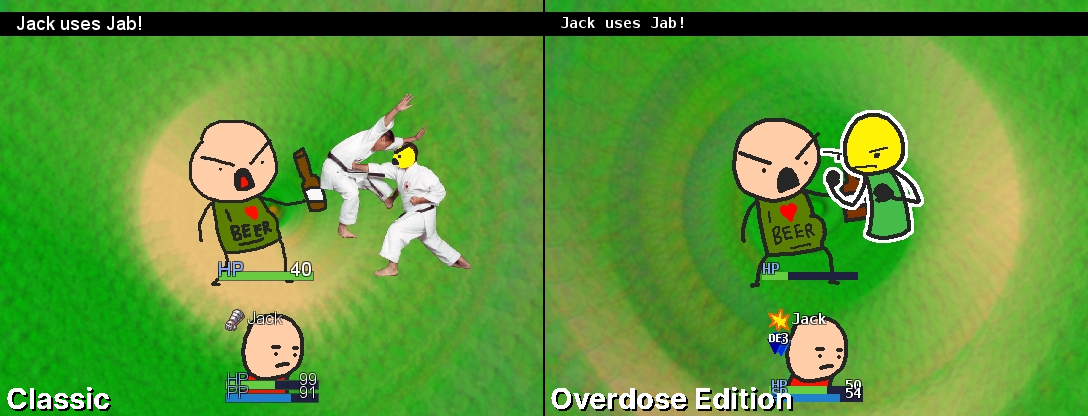
RPG Maker VX Ace was frequently on sale on Steam for dirt cheap, so I got a copy for around $10 in early 2016. And so it began. Crackhead Jack had an even older prototype from 2015 that I have since lost to time and a long-forgotten MEGAupload account (You can guess how I got that VX Ace copy before buying it on Steam). That prototype had a simple premise — bald-guy-with-red-shirt Jack (shoutout to Kurt in Vinesauce Joel’s BBQ Quest) was on a quest to find crack. There were only 3 bosses at the time: Pepsiman, the Kool-Aid Man, and a dark-hooded edgy cult leader that eventually joins your party (Matthias in BBQ Quest). So with a fresh, legitimate copy of VX Ace, I set out to “remake” that prototype and put more effort into the visuals of it. BBQ Quest still retained a lot of the default RPG Maker Runtime Package (RTP) assets, having only unique sprites for characters and other minor things. Since I had a drawing tablet, I decided to put more effort into creating entire tilesets from scratch, to also avoid having to require the RTP to run, shaving off a whopping 150 MB from the game’s size.
Eventually, in high school, my new circle of friends there were introduced to this 2016 version of Crackhead Jack. I had always thought to myself that I could do better than that. So it began, the Overdose Edition.
It’s really easy to get your game on Steam
What I didn’t expect when getting an application for Steam Direct was how simple it was. Maybe I should have been less surprised, given all of the shovelware garbage, adult games, and achievement farms that get on the storefront. Even then, there is a lot of consideration for the process of getting a game on Steam. There’s a reason why Steam is the top gaming platform on PC despite all the garbage — the developer and publishing tools are so fleshed-out and easy-to-use that I would’ve never considered other storefronts or platforms. To me, this is what justifies the 30% cut Valve gets from the game’s sales. Valve does a lot of the heavy lifting on the service side, and it just so happens to treat its customers well enough to keep retention so high for so long.4
Steam achievements were fairly straightforward to implement. Thankfully, somebody wrote a script that integrates the Steamworks SDK for achievements. As far as I know, there isn’t any solid Steam Overlay support given how old the engine is (and everyone’s moved onto the JavaScript-based MV/MZ), so that was out of the picture. Steam Cloud is also dead simple. Specify a file type or directory and you’re (mostly) ready to go.
It’s also very clear from this process that Valve doesn’t really thoroughly check and/or test your game. It’s pretty much “does it run? Can I plug in a controller? Cool” and testing is complete once whoever is testing your game at the time reaches the title screen or equivalent screen. I can imagine this is the same for testing for Steam Deck verification, but the games Valve selects is largely based on the game’s popularity and/or the reputation of the publisher. All that being said, the application review and testing for Crackhead Jack: Overdose Edition took a week and the store page was pretty much public by June 2020.5
My shitty approach to marketing
There was hardly any marketing/advertising done for the game. Most of it was my reluctance to really spam it everywhere given its subject matter and overall niche appeal. I had made a few posts on Reddit any time the game went on sale, and updated the original 2016 game’s pages to point to the Steam page. I also posted a couple times on Twitter, but on all of these fronts, they were all admittedly half-assed. In this decade of YouTube and Twitch, it’s probably more risky to stream this game than ever. Lesson learned, but in the end its niche appeal reached enough people for me to be satisfied with the work I did.
My suggestion for any aspiring indie developer is to follow the trends of everyone else: posting random in-progress gifs on “Screenshot Saturday”, blog/devlog posts, other engagement. Some of my favourite games were discovered through word-of-mouth and discovering cult followings, so there’s always the nugget of hope I have for the game becoming “popular” in the same way that people would remember the Madness or Stick RPG flash games from way back when. Though those games were already huge at the time of their release.
The re-release (and its design)
The story and writing
I really, really dislike how Crackhead Jack 2016 is written. For Overdose Edition, I rewrote all of the dialogue and plot progression of the game. There are completely new sidequests written with the help and ideas of some close friends, and the overall pacing is improved.
Crackhead Jack 2016 has not aged well to me at all. There’s a cheap Skyrim reference right from the start. Instead, Overdose Edition has a proper “tutorial” that makes the player use all of their controls before getting into the plot. The cops in are more fleshed out characters; they also actually set up the plot proper this time. It’s also sort of intended for them to be the implied villain throughout the story. But, as it is in any JRPG, the true villain lies within a deeper secret. Jack, Himoff, and Loogie, all of the party members, are also more “fleshed out” and have their own characteristics to them. 6
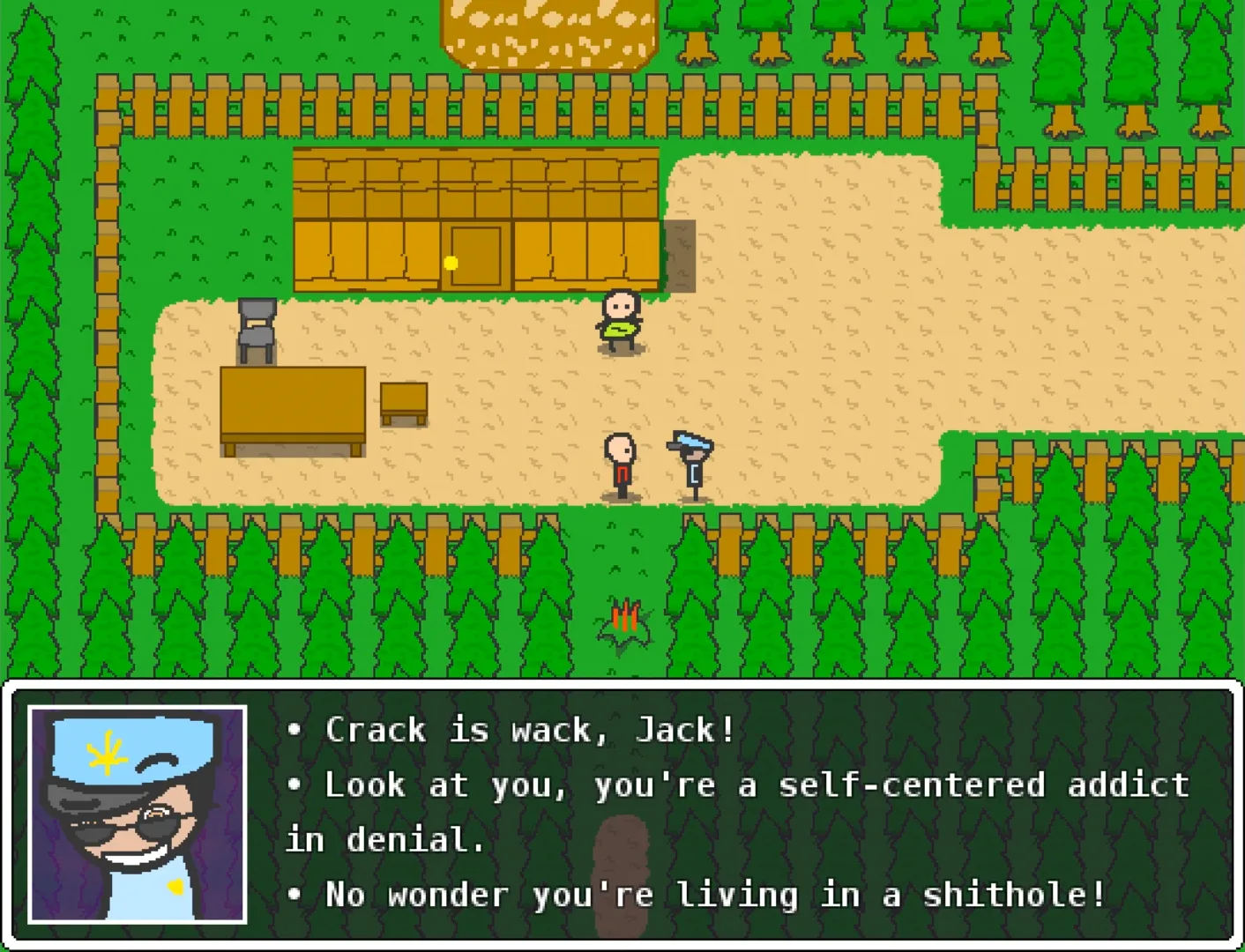
I won’t go too far into how different the story is, I encourage you to play it yourself if you know what I am getting at. Playing through P4G really reminded me of the peak JRPG tropes that I both love and hate, and it informed the pacing of where I was going with Overdose Edition’s writing. Obligatory fake outs, withheld information, cheap jokes, typical JRPG story beats, all poorly condensed and executed in my game.
The original soundtrack
I always considered music in video games like these to be pretty important to the identity of a game, especially indies. (They’re also coincidentally a defining quality of the Persona series, whatddya know!) The 2016 game pretty much uses chiptunes from other NES/SNES/GBA era video games or chiptune covers of Metallica and Megadeth songs. Pretty much in the same fashion as BBQ Quest’s BGM.
Overdose Edition’s music direction was intended to be in the VGM categories of “oddly good for the type of game it’s in” if you know what I mean. I figured this was the type of video game adjacent with an audience familiar with Adult Swim and Newgrounds, so there are a lot of hip-hop and drum-and-bass influenced tracks7 for the game’s OST.
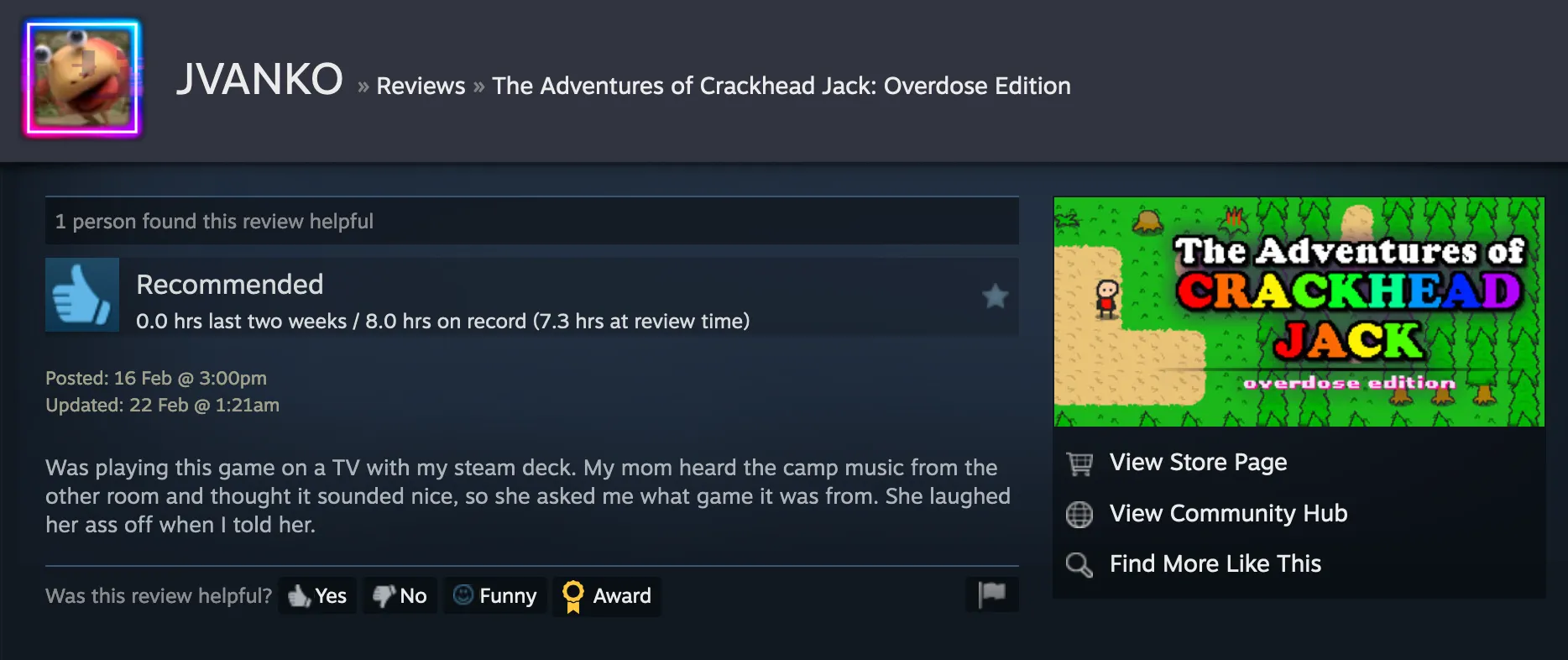
I am grateful enough to have friends talented enough to crank out a full game OST in the span of a couple of months — the game didn’t have a set-in-stone group of musical artists until around March of 2020. And even then, each track took from a couple weeks to a month of back and forth feedback and sound testing. The original soundtrack in its entirety was only completed about a month before the game was set to release on Steam. If I had one regret, it was not asking for .wav/lossless copies of the music. The soundtrack on Steam is only 192kbps (the game uses .ogg versions). I could’ve increased the price tag if that was the case, but by the time the game was about to release, I did not have raw copies of certain songs (the Shop themes,8 Factory theme, and Loogie’s theme, originally composed in 2017).
There are also tons of references to music I enjoy and listen to littered throughout the game,9 especially through the achievement names. I won’t list out every reference, but take a look at the achievements list on Steam and see how many you could get!
The enhancements (random encounters and UI)
P4G’s dungeons do that thing where you can choose when random encounters occur on dungeon floors, by having the player physically attack or touch the enemy. I don’t know why I hadn’t considered that mechanic (this is like a decades old trope from Dragon Quest, even) when creating the 2016 game, it was probably my Pokemon brain. And partly RPG Maker VX Ace’s default options for encounters being “run around range x of tiles before a chance of an encounter occurring”.
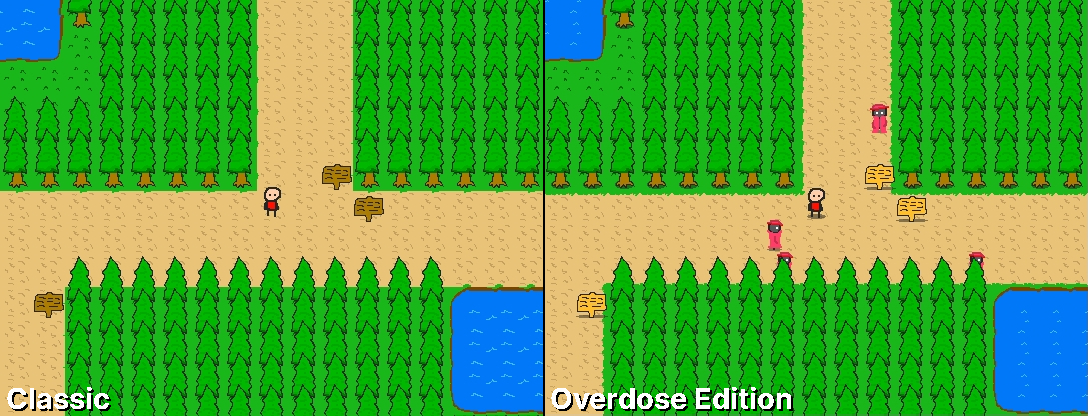
The UI’s layout is slightly adjusted to remove any useless elements that were not useful for the game. Similarly, the title screen is more stylized and allows for more game/system options to change. There’s also a small addition where completing the game both with or without doing drugs in the playthrough adds a star to the main menu (I took inspiration from Five Nights at Freddy’s (2014)).
The random encounters in Overdose Edition are scripted by myself in the VX Ace interface (not using Ruby, but that damn line-by-line dropdown-selector-simulator baby mode): their movements, respawn times, and flags when Jack uses the Horn. The Horn item is there to respawn the encounters, purely for grinding purposes. However, unlike the random encounters in the 2016 version, there are some additional things that are pre-determined:
- Initial location of enemies. This was something I considered for ease of speedrunning and also play testing. It was easier for the game to not bug out if the player was certain where enemies would spawn each time they entered a zone.
- Respawn time. It takes like a minute or so for them to respawn, and they respawn where you defeated the previous encounter.
- Fine-tuned encounter events. The behaviour is different depending on the area Jack’s party is in, mostly their move speed and detection range. There is an internal game level that stores all of these encounter events for me to copy paste10 into their respective playable maps.
- They all share that same red-coat-white-eyes look, basically to emulate what I’d imagine Persona 4’s Shadows to look like in this universe.
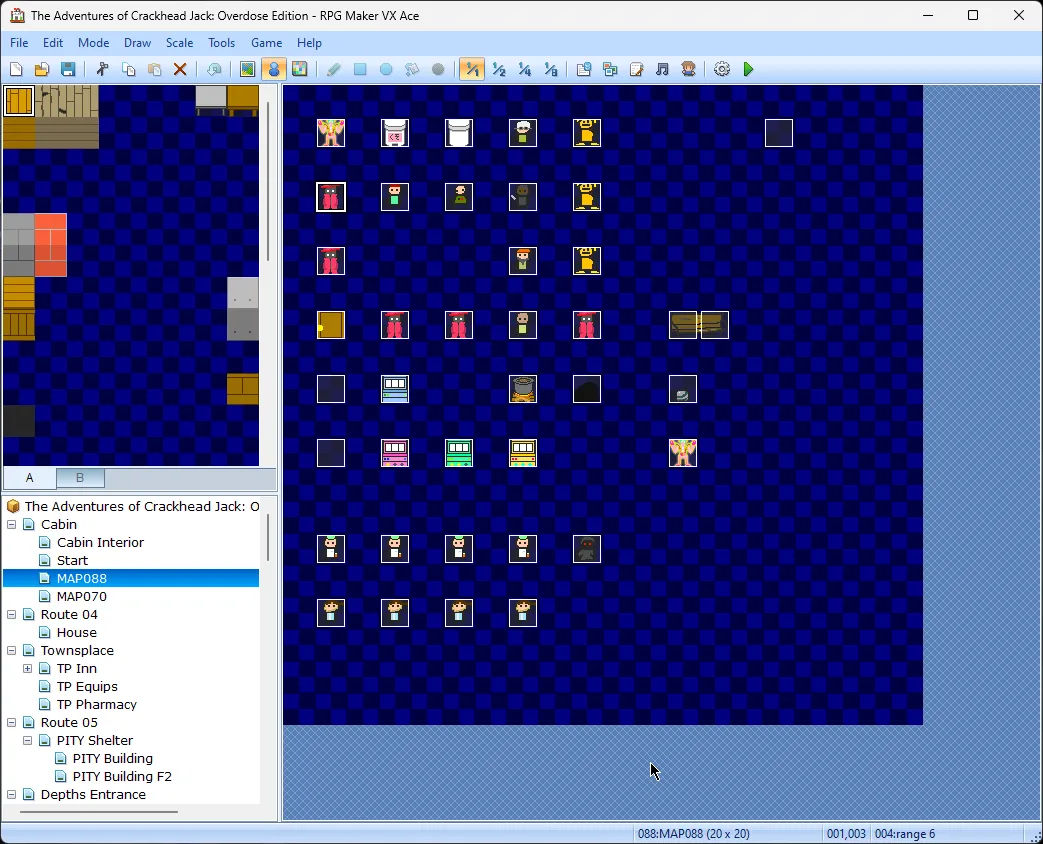
These core changes make up the bulk of what makes Overdose Edition a far more polished version of the game, in my opinion. There’s also the better challenge mode than the bog-standard “hard mode” you’d see in games post-completion.
The hardcore gamer “challenge” mode
Personally, I don’t really like difficulty selectors in games that aren’t rhythm games. Especially for an RPG. Crackhead Jack 2016 had a “Hardmode” that was accessed with a code that you get at the end of the game. It was your typical “hard mode” in a game like this; increased HP and ATK for the bosses, and slightly different dialogue.
I didn’t really want to cheap out on that kind of artificial difficulty boosting, so I opted for making an achievement for a “challenge” run, in particular completing the game without doing any drugs (a Straight Edge Run). I always enjoyed people running through video games with some weird self-imposed restriction applied (really I just enjoy soul level 1 runs in dark souls and SASO runs in hitman haha). I figured with the game’s themes, someone would try to complete the game while keeping Jack and the party sober the entire time. To my surprise, around 2.5% of players who own the game on Steam actually got the achievement for it.
The Straight Edge Run explainer
In Overdose Edition, every time a drug item is consumed (every consumable remotely related to being a drug, such as the standard healing items, opioids), a flag is triggered that basically tells the game you’ve done drugs. The game doesn’t acknowledge you are “straight edge” until after beating the Fizz Boss (something like a quarter of the way into the game’s story, after defeating 3 major story bosses). Once the Fizz Boss is defeated, an NPC will appear near the area’s exit telling you that you are in the middle of a Straight Edge run.
Later on, during the cruise ship sequence, there is a slight change in an evening cutscene that sort of makes reference to Jack having not done any drugs in the adventure. Other than that, that’s really it. You won’t know for sure until you beat the game and get the Steam achievement popup.
Assistance with the challenge is also not really provided through the game’s item shops and chests. Most of the items you get are drugs, and drugs are the cheapest items you can get. However, the game does get more generous with sober items that are comparable to the drugs, since mostly they are packs of energy drinks, etc. that affect the entire party. Using drugs, however, makes the game more in line with what I envisioned the difficulty to be, ie. stocking up on weed and meth to boost attack speed for a few turns and get it over with. I will honestly have to give the Straight Edge run a go now that I write about it, but it would delay this far more than I already have. (Yes, I admit I never actually completed this challenge run myself, but thankfully it works!)
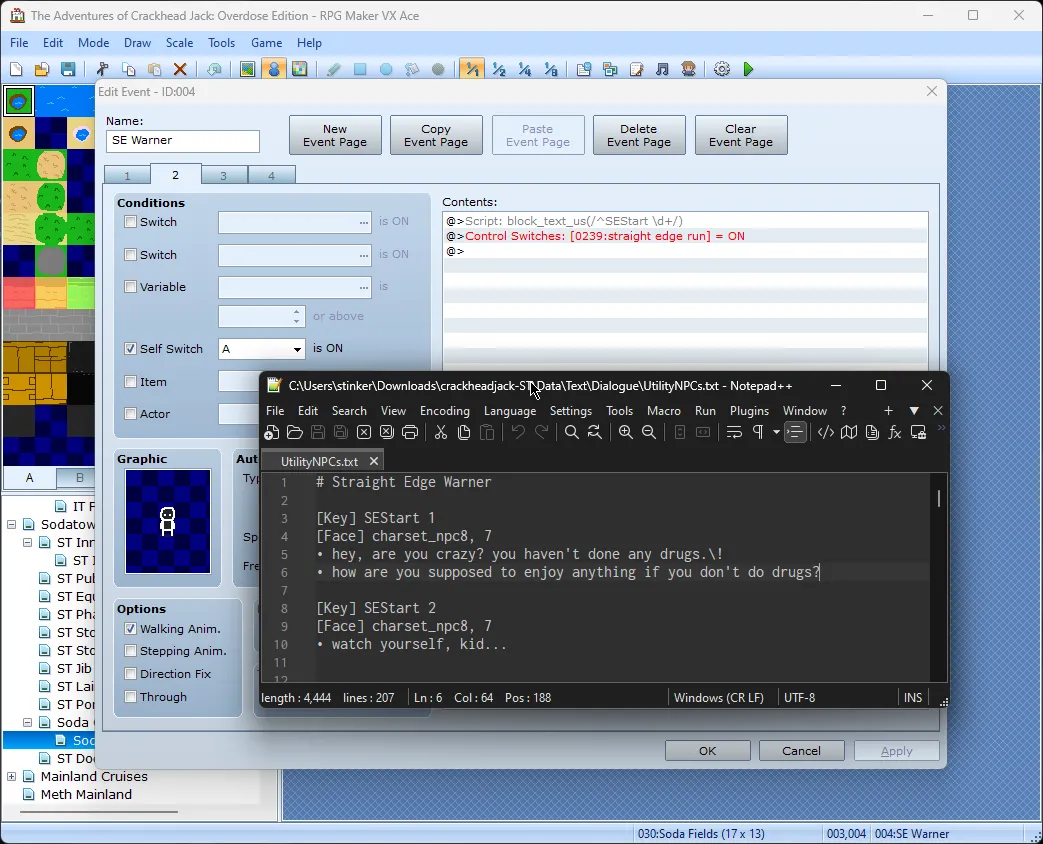
(Yes, all dialogue and text that appears are stored in plaintext in the game’s directory. This was originally done to accommodate a “censored” version I was going to release on GameJolt as a joke, as a free version of Overdose Edition where 50% of the dialogue was to be censored. Turns out it was a lot of work for a joke. I also figured it would be easier this way in the off chance someone would ever want to translate this game.)
There must be something to completionists and JRPG games, or maybe it is simply the passion of some Steam gamers, but as mentioned earlier, 2.5% of players of Crackhead Jack Overdose Edition on Steam have the Straight Edge run achievement. Maybe there’s a simple way of doing it, but I honestly have never tried after having played through the game a gazillion times. I’m glad it works at least, and the one achievement guide that mentions it also says it is hard. So it works.11
Re-releases are a dying art
Re-releases are good actually and are beginning to lose their expressiveness in the age of patch culture, early access, and digital ownership. Though this is only really apparent in the AAA industry, which is hardly worth anybody’s time anymore. It’s easy for some nobody like myself to re-release some “enhanced” version of a shitty old freeware game on Steam, but it took me back to a time where version updates were entirely new releases/“updates” of games and having a clear “timeline marker” of when games got good or what versions people prefer. Like Hideo Kojima’s recent Death Stranding Director’s Cut (2021) for PS5, where he embraces the film influence that is strong in all of his works. His Metal Gear Solid series also had these style of re-releases, like Substance for MGS2, and Subsistence for MGS3.
In all honestly, this is just me looking back with nostalgia on these older re-releases, like Persona’s, and major revisions for fighting games.12 Is it only me in believing these point releases helped these “live-service” games more than what we have for “seasons”, patch notes, and expansions? Yes, because there’s probably years of revenue data that proves otherwise. An entirely new release warranting a new marketing cycle for the publisher, gauging continued interest in a long-standing franchise and/or game. Publishers literally sold the same game with a major update or revision, often for full price again. Who could say no to that?
The publishers would say no.13 To that extent, we may never see another major re-release like this in the AAA space again, unless it is simply another “remaster” or “remake” of a game, where a larger budget could be allocated into “reimagining” an older title. “Game of the Year” and “Definitive” editions of games are the standard nowadays, where DLCs and other extra update content are bundled in at a discounted price. Standardized, sure, but is it as “expressive” as the re-releases of old?
Trying to wrap this up
I am probably coming across as if I cannot let go of this game almost 10 years on, but I cannot deny that the experience I had working on it changed my outlook on what this game development hobby is to me. It’s my main creative outlet, and now working on Idlenet, in a completely different engine/framework, in a completely different genre of games, has me rethinking how I’ll want to promote it for the appropriate audience. A more flexible framework to work on the game (Lua+Love2D), documenting more of what I’m doing and how it all works, and a more organic marketing approach (starting early, gathering feedback, … early access…), a game I will want to look back on with fond memories. In the same way Persona 4 Golden influenced Crackhead Jack Overdose Edition, Kittens Game (2015) and Idling to Rule the Gods (2014) will influence Idlenet. I’m well aware that it’s a game for an entirely different audience too, but this is my hobby after all, I like to make games that I would actually play myself. That is a high priority for me. I hope my games from here on will speak for themselves.
Footnotes
-
RPG Maker was something I always wanted to mess around with, since the scripting was light enough to where I could focus on other things when making a game, like art, story, music, and balance. In a time before I started with GameMaker 8 in middle school,14 I had used RPG Maker XP because I had ambitions of making a Pokemon ripoff or romhack. I wasn’t so hellbent on optimizing code or rewriting entire systems to accommodate another. My young self wanted to design, write, and make a game, not expecting to do boring and tedious coding. In 2014, Vinesauce Joel streamed himself playing a game he made with RPG Maker XP (or VX? not really sure) from 2007 titled BBQ Quest. If you took just one look at that game, you can see where the inspiration for Crackhead Jack’s setting originates. ↩
-
Looking back, I should’ve considered itch.io more, and Crackhead Jack 2016 was in fact on itch.io for a short period of time. It would’ve been cheaper. I was stupid at the time and maintained two separate versions when in reality I could’ve had GameJolt trophies in the itch.io version without issue. ↩
-
I try to restrain myself whenever the game comes up. I hate to be associated with some rabid fans, but it can be very likely when a game is so good (see: Portal). Persona 5 Royal (2019), as I previously mentioned in the post about racing games, is one of my favourite games of all time. That game consumed me for an entire month, and I couldn’t play anything for a week after getting the true Royal ending. There’s a term for that, I think. ↩
-
Though let’s not ignore how 20 years ago Valve pretty much forced any buyer of Half-Life 2 to use their archaic always-online DRM and locking the game behind Steam despite buying a CD for it. It always seems to do major service innovations first and have the rest of the industry poorly imitate. If you are ever approached for an Epic Games exclusivity deal, you should take it as preparation for when your project actually releases on Steam. ↩
-
The game’s soundtrack took longer to get approved, mostly because of my inexperience with mixing music and leaving some bits of extended silence in some tracks (unintentionally). Whoever was reviewing it at Valve also didn’t like the cover art. I vividly remember in my reply to the feedback, with me saying that it was a reference to my bloody valentine’s Loveless cover art. It was approved after that. ↩
-
Jack is intentionally one-note and attempts to no-bullshit his way to anything that gets him closer to crack. Like what I’d imagine a crackhead to be, basically. He’s as close to the “straight man” comedy trope as can be in this universe, ironically. Himoff is full of himself, has main character syndrome. Acts like an idiot once the story gets going because he thinks he knows everything that is going on in Jack’s quest, but that inevitably goes awry. Loogie is still a joke character, he kind of adds on to the inexplicable le rand0m bullshit that goes on in the game, and has a really cheap joke near the end. The jokes from him are less juvenile than the 2016 iteration. ↩
-
Some honourable mentions: my personal favourite song from the OST is the Fizz Boss theme by Yung Data. I basically asked him for a eurobeat sounding song, since this is the spiritual successor to the Pepsiman fight, known for his high agility and evasion. It’s the best boss track to put on loop, and has a very great and well-placed can-opening sound effect right before the beat drops. It’s great. Yung Data also composed the Town music; I love how simple it is. For a reference of what kind of song I wanted for the town music, I sent him the Viper song “That Baller Out Your Best Side” because to me that song had always sounded like a NES JRPG track with deep rap over it. But most of You’ll Cowards Don’t Even Smoke Crack is an inspiration for the style of the town music. Overblown bass line, a light synth or some old-school music bank with flutes and other woodwinds that you’d hear in an 90’s Nintendo game, and very simple drumbeat. Perfect background music for roaming around town. The A.P.E. song also had a simple requirement: I asked Yung Data for it to sound like a twisted interpretation of a song from the Touhou Project series of games, since in my opinion it’s in my top 3 favourite bossfights that I designed for the game. It has a “unique” minion gimmick and feels like the tipping point in the game where I am actually testing the player to see if they get the hang of the combat. Not only that, but Jack’s party members also get the story rolling, and I’d timed the party’s Limit Power for their limit skills (yes, limit breaks straight from Final Fantasy) to be ready for the fight. And I think it went very well. ↩
-
I personally only “composed” like 3 tracks for the game, in reality one actual composition (the Shop/Cabin theme) and two joke tracks that have different mixes to them. One of them is an “ambient” song that I actually recorded while I was working in my old job during a graveyard shift. I added some extra BS to it to make it sound more spooky. The Shop theme was hastily made in FL Studio 11 with an Animal Crossing soundfont, as a placeholder melody for what I was going for in terms of mood, but I ended up liking the song enough to keep it in. ↩
-
One of my favourite tracks from the game’s OST is the music for the Meth Mainland area, by Sam Wakeman (part of Rainy Day Ritual — check out their music!). I remember specifically asking for a Boards of Canada-like song; specifically sending him the song “Turquoise Hexagon Sun” from Music Has The Right To Children. If you listen to these tracks back-to-back, you could immediately tell. For the battle themes, I sent the Kanye West song “Crack Music” from Late Registration, mainly for the drumbeat, but the interpretation of the vocal melody is very well done as well, though its influence is not as apparent as Meth Mainland’s theme. It’s a coincidence the track is named that way, I just like that album a lot. They’re all amazing tracks, and let’s not forget the final moments of the game where intense shoegaze tracks come in. Culminating into an intense industrial(?)/experimental hip-hop track for the final boss. I love hearing it. ↩
-
I’m not crazy enough to copy paste the events in such a way that editing universal logic would mean that I go into every pasted encounter and change it one by one. There is a custom script call in each encounter that calls a singular Common Event that I need to maintain. Why this isn’t basic functionality in RMVXA is beyond me. Maybe it’s better in later iterations of the engine. ↩
-
Of all the aspects of releasing on Steam, the trophy finders of the world fascinate me the most and I personally love looking at the global graph for achievements in games. Seeing the distribution of Overdose Edition, with “beating the game” being at a what I consider “healthy” ~20% of the playerbase, leaves me proud of what I have accomplished. It absolutely boggles my mind that 2.5% of the 400ish people who own the game on Steam played through the entire game twice over in order to get the achievement. 10 people is a crowd. ↩
-
Think of Street Fighter IV (2008), from arcade/first console release to “Super Street Fighter IV” (2010) for consoles and later “Ultra Street Fighter IV” (2014). However USF4 was available as both a paid update for SSF4 owners, as well as a separate retail game, because those were still feasible options back then (10 years ago!). Same goes for Tekken, where often the 2nd or 3rd iteration of a Tekken game with a subtitle (like “Dark Resurrection” for Tekken 5’s PSP/PS3 release, “Bloodline Rebellion” for Tekken 6’s console release, and “Fated Retribution” for Tekken 7’s console release/arcade update) is the “definitive” version of those games. ↩
-
Even with Steam and all of the praises I’ve sung about its ease of use for developers, we now have AAA games that are themselves launchers to their franchise entries. Major re-releases are simply not as viable these days. 10 years ago, Ultra Street Fighter IV was being sold as both a game “upgrade” as well as an entirely separate retail game. Could you imagine being the person who must manage these app releases and communicate differences between them to their customers? When every storefront can have their own unique dark patterns to influence purchasing habits, with their own systems of cataloguing games, DLCs, soundtracks, even software? Tons of money goes into the first hype cycle, and players have already been conditioned into following developer communications and eagerly awaiting patch notes and new “seasons” it might as well be a lost cause. ↩
-
I could have made Crackhead Jack with GameMaker, the engine whose language GameMaker Language (GML). Around the time Undertale (2015) released, it blew my mind knowing it was made with GameMaker 8 (the original Kickstarter demo was) and Studio (for the full game). I had eventually cooked up a really basic RPG-style system with movement, textures, and textboxes, and it wasn’t a straight up copy from a video tutorial series. My previous projects at the time were pretty much code copies from tutorial series, one being a Hotline Miami ripoff (the main reason I got into GameMaker in the first place, as that game was made with GM8), and a Five Nights at Freddy’s derivative (the trend at the time on GameJolt in 2014-2015). In the end, RPG Maker was easier for me to get the ground running. ↩